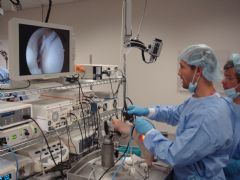Undeterred, the athlete in question has worked really hard to return to full training & pre-season has seen a return to the promise that her coach believes will see her achieve success in the sport. Unfortunately, the ankle continues to stiffen up & whilst she does her best to get it mobilised, it does influence her biomechanics on occasion. In addition, the knee on the same side has grumbled along over the last month or so & an ultrasound scan recently confirmed suspicions of a patella tendinopathy. Consequently, she is on a course of triple therapy & is working hard once again to rehabilitate the functional chain concerned, including an isometric heavy loading programme to target the tendon itself.
This isn't the first time I have encountered an athlete with an old ankle injury that has had a subsequent patella tendinopathy. In fact I recall a young female basketball player I treated 6 months following ankle surgery & had been struggling with patella tendon pain since returning to training; a footballer with a long history of ankle problems & a diagnosis of "Footballers Ankle", presenting with persistent distal patella tendon pain & a rugby player with a not too dissimilar history.
It doesn't take rocket science to reason that a reduction in ankle dorsiflexion will influence the entire functional chain from the bottom up - the energy storage & return properties of the achilles tendon, the eccentric strength of the triceps surae in controlling the dorsiflexion movement at the joint on landing & the overall landing strategies are all critical factors affecting the load on the patella tendon.
Several theories have been proposed for the pathogenesis of patella tendinopathy, relating to both intrinsic & extrinsic factors. Extrinsic factors include training intensity, training surface, nature of training & footwear. The intrinsic factors are the ones that dictate why one person exposed to the same training characteristics as his/her team-mate suffers from a patella tendinopathy, whilst his/her team-mate doesn't. It has been suggested that strength, flexibility, muscle balance, hip circumference, patella alta, patella mobility, jumping techniques, landing strategies, tendon elasticity, height, weight, gender, age, muscle endurance & hormonal profile all may influence the presentation.
Basketball is one of the sports where patellar tendinopathies are prevalent & a prospective study by Backman & Danielson, published in the American Journal of Sports Medicine in September last year, assessed the relationship between a reduced range of ankle dorsiflexion ( < 36.5 degrees) & the presentation of patella tendinopathy in a population of junior elite basketball players (n=75, 38 males & 37 females).
Range was assessed at the initial testing, following a standardised warm up, using a reliable & valid weight-bearing lunge test (Bennell et al, 1998). Follow-up was performed a year later. Players who developed knee pain during the course of the study were investigated & diagnosed at the time the symptoms presented & were included in the study even if the symptoms resolved before the study reached a conclusion. Diagnosis of patella tendinopathy was reached following a history of activity-related knee pain & reduced function; distinct palpation tenderness corresponding to the point of pain & pain provocation in response to a single-legged decline squat test. Worth noting was the lack of inclusion of ultrasound or MRI scan investigations due to the low predictive value of the modalities in the diagnosis of patella tendinopathy as reported by Cook et al (2001), Kahn et al (1999) & Lian et al (1996).
At follow-up, unilateral patella tendinopathy was reported in 12 subjects (8 males, 4 females), giving a 1 year incidence of 16.0%. There was no statistically significant difference between the presentation of tendinopathy between dominant & non-dominant legs. The means for each potential risk factor noted at the baseline testing for each subject were compared between the normal & tendinopathy subject groups at follow-up using the independent-samples t-test. For each leg, the mean range of ankle dorsiflexion at baseline for the tendons was compared between diagnosis groups (tendinopathy v normal) using the independent-samples t-test.
Results showed that players who had developed tendinopathy over the period of the study had had a statistically significant reduction in ankle dorsiflexion range (mean difference of 4.7 degrees to 5.1 degrees depending on the leg) at baseline testing compared with those subjects that remained asymptomatic throughout the course of the study.
All in all, a very interesting paper & worth a more thorough review. You can download the paper by clicking the link below:
Let me know your thoughts in the comments box below!

